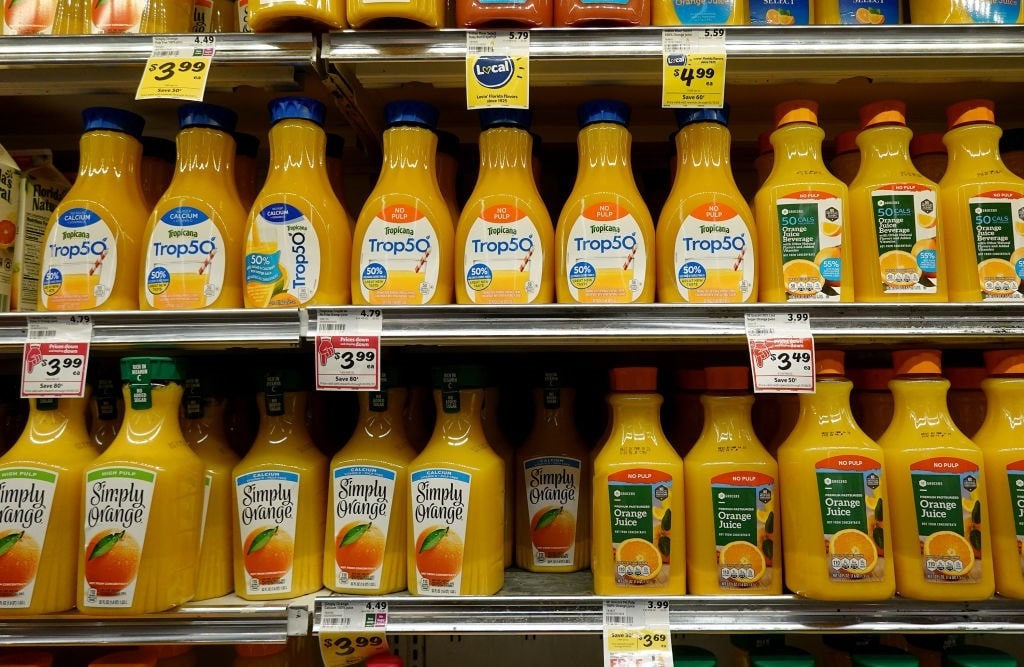Here is a year-to-date percentage gain for an asset in the global financial markets: 54%. No, this is not the performance of a meme stock, cryptocurrency, or carton of eggs. Orange juice prices have enjoyed a 54% rally this year and an even more significant 12-month spike of more than 82%. But why is the classic breakfast staple one of the top-performing assets in the world today, and should you stock up on bottles of Tropicana or Oasis?
A Fresh Squeeze of Orange Juice Prices
Orange juice prices took a breather from their year-long surge on the US ICE Futures exchange last week, recording a 3.2% weekly loss. Still, the agricultural commodity recently touched a record high of $3.41 per pound before sliding to $3.14 to finish the September 1 trading session. Have investors priced in supply fears and strengthening demand, or is there still more room to squeeze out some gains? It depends on what happens in Brazil and a particular disease.
For the last decade, Florida’s farmers have been devastated by citrus greening, a disease that results in oranges dropping before they are ripe. This has caused a significant decline in production over the years. For the 2022-2023 marketing season, US orange juice production has cratered 47%.
Brazil, which has transformed into the world’s largest orange juice producer and exporter, is beginning to spot citrus greening in pockets of the country. One-quarter of orange trees in Brazil’s crucial producing areas are estimated to possess the disease. That said, even before there were indicators, the South American nation was already poised to export 2% less orange juice to the US than a year ago.
“The proliferation of disease continues to be great in Florida, and the chance of a large comeback in production for the new season is limited,” said Judy Ganes, president of J. Ganes Consulting, in a recent interview with Bloomberg TV. “There are signs that disease is more prevalent in Brazil, too, which is also facing long-term problems with their crops.”
According to the US Department of Agriculture, global orange juice output declined 9% in the 2022-2023 marketing season, with total production falling to 1.5 million tons. Experts warn that output slowdowns and strong juice consumption could see two trends: higher prices and plummeting shipments.
Oil You Need Is Saudi Arabia

(Allen J. Schaben / Los Angeles Times via Getty Images)
US crude oil is above $86 per barrel on the New York Mercantile Exchange, while a gallon of gasoline and diesel have topped $3.81 and $4.46, respectively, nationwide. Black gold has enjoyed an incredible rally since the end of June, soaring nearly 20% and adding to its year-to-date ascent of almost 7%. Supply concerns have primarily driven the upward movement over the last couple of months, and the latest development to add to Texas tea’s increase involves Saudi Arabia.
Bloomberg compiled data from Vortexa and Kpler analytics and reported that total exports from Saudi Arabia were 5.6 million barrels per day in August, down from 6.3 million barrels a day in July. This represented the weakest number since March 2021. The numbers also revealed that exports to China have declined, shipments to Japan and South Korea were the lowest since Bloomberg started tracking Riyadh’s exports, and cargoes to the US and Egypt were at a six-year low.
The kingdom has been one of the key contributors to the rise in oil prices. Saudi Arabia has cut production and could extend the reduction into October, fueling the jump in crude since its objective is to establish a price floor of $70. At this point, forget $70. Businesses, consumers, and investors might need to brace for $100 again.
Oh, and give President Joe Biden some blame, says one industry analyst. “Those policies and Biden’s policies and his poor diplomatic relationship with Saudi Arabia is that main reason why Saudi Arabia seems intent on sticking it to us when it comes to reducing oil production. Even as global oil inventories start to plummet as global demand exceeds daily production levels, reports say that the Saudis are going to extend the famous lollipop million barrel a day production cut through October,” wrote Phil Flynn, senior energy strategist at the PRICE Futures Group, in a note.
Bankrupt
US corporate bankruptcies continue to advance as rising interest rates, tighter credit conditions, and a slowing economic landscape weigh on debt-laden firms. New data from S&P Global Market Intelligence show 64 corporate bankruptcy filings in July, the highest figure since March. There have been 404 bankruptcies in the first seven months of 2023, surpassing 2022’s full-year tally. A decade of cheap money fostered a climate of zombie companies, and the pandemic-era stimulus and relief programs delayed the inevitability of these companies’ demise. With monetary policy acting with a lag, the full effects of a 5% environment have yet to be felt. Next year, at this time, how many more bankruptcies will there be?




